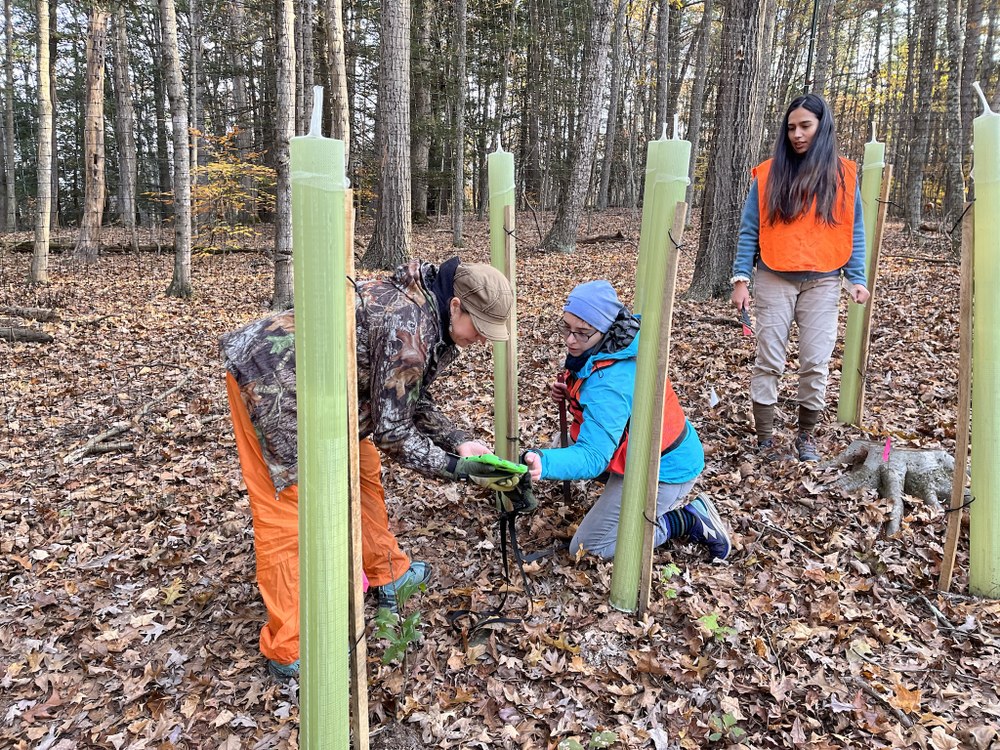Our research focuses in forest ecology through a range of research approaches that include dendrochronology, vegetation sampling, ecophysiology, and ecosystem science.

2022 Fieldwork in Stone Valley Forest
An overarching theme to our research is how climate, bedrock, human land use, invasive species and disturbances like fire affect forest dynamics through time and space. Research projects include a diversity of regions such as eastern deciduous forests, semi-arid woodlands in the western United States, and forest of the Iberian Peninsula. Most recently, our group has focused on the responses of northeastern deciduous forests to climate change, invasive species, and bedrock.
Current projects (2022)
Managing forests for carbon and climate adaptation: Pennsylvania hosts 6.8 million hectares of forests that provide important ecosystem and cultural services such as carbon sequestration. Yet, our forests are vulnerable to global stressors such as climate change. Forest management is our most effective tool to ensure continued forest resilience and productivity, but few examples exist that demonstrate how silviculture accelerates carbon uptake while simultaneously actively managing for climate resilience. Through this project we are designing forest management protocols to promote carbon storage in mature trees while ensuring the regeneration of climate-adapted tree species. The research is taking place in Penn State’s Stone Valley, with the initial harvest and climate adaptation plantings happening in Spring and Summer of 2022.
Growing Penn State's forestlands: Penn State owns and manages over 2000 hectares of forestlands near the University Park campus in central Pennsylvania. These forests have been managed sustainably for wood products in the past, more recently there are wildlife habitat management projects being installed and maintained, and the forestlands hold tremendous potential to produce knowledge about forest management for other ecosystem services such as carbon storage, non-timber forest products, and recreation. Our group as compiled information about current and past forest management and research projects in the forestlands in a Stone Valley Forest storyboard.
Social and ecological capacity of small forestlands to produce multiple ecosystem services: this project will begin in July of 2023 and includes social and ecological assessment of small privately owned forestlands to produce multiple ecosystem services, with a focus on carbon, wildlife habitat, and food from native understory plants/organisms. We will conduct landowner surveys about their capacity to manage for multiple ecosystem services and use field sites in Penn State’s Stone Valley Forest to collect empirical data on ecosystem service production and model forest carbon dynamics.
The impacts of an abundant woody invasive shrub community on a native eastern deciduous forests: this is an ongoing project in our lab, which started in 2009 when lab members all pitched in to clear woody invasive species in five plots in Penn State’s Hartley Woods in the Arboretum. Since 2009 we have been periodically clearing the woody invasive shrubs and studying the removal impacts in five sets for paired plots (treated and control). These plots have been the basis for several undergraduate and graduate students.
- Maynard-Bean, E. and M.W. Kaye, 2021. The seasonal influence of invasive shrubs on light and temperature in an eastern deciduous forest understory. Natural Area Journal 41: 186-194. https://doi.org/10.3375/043.041.0304.
- Maynard-Bean, E., M.W. Kaye, E.E. Burkhart, & T. Wagner, 2020. Citizen scientists record novel leaf phenology of invasive shrubs in eastern U.S. forests. Biological Invasions, DOI: 10.1007/s10530-020-02326-1.
- Maynard-Bean, E. and M.W. Kaye, 2019. Invasive shrub removal benefits native plants in an eastern deciduous forest of North America. Invasive Plant Science and Management 12: 3-10.
- Kaye, M. W. and C.M. Hone, 2016. Removal of invasive shrubs alters light but not leaf litter inputs in a deciduous forest understory. Restoration Ecology 24: 617-625.
Integrating critical zone science into forest ecology and management: In 2012 our group had the good fortune to become involved with the Susquehanna Shale Hills Critical Zone Observatory. Two graduate students have based their research on this project, and our group has been involved in many aspects of the monitoring of forest dynamics in relation to bedrock. We are also part of a USDA National Needs Fellowship project to train graduate students in the field of critical zone science and forest management.
- Kopp, M.W., D. Alving, T. Blackman, M.W. Kaye, J. Duncan, J.P. Kaye, 2023. Critical zone perspectives for managing changing forests. Forest Ecology and Management 528: 2023. https://doi.org/10.1016/j.foreco.2022.120627.
- Reed, WP and M.W. Kaye, 2020. Bedrock type drives forest carbon storage and uptake across the mid-Atlantic Appalachian Ridge and Valley, U.S.A. Forest Ecology and Management, 460:117881.
- Brubaker, K. M., Q.K. Johnson, and M.W. Kaye, 2018. Spatial patterns of tree and shrub biomass in a deciduous forest using leaf-off and leaf-on lidar. Canadian Journal of Forest Research 48: 1020-1033.
- Smith, L. A., D. Eissenstat and M.W. Kaye, 2016. Variability in aboveground carbon driven by slope aspect and curvature in an eastern deciduous forest, USA. Canadian Journal of Forest Research 47: 149-158. Editors choice.

